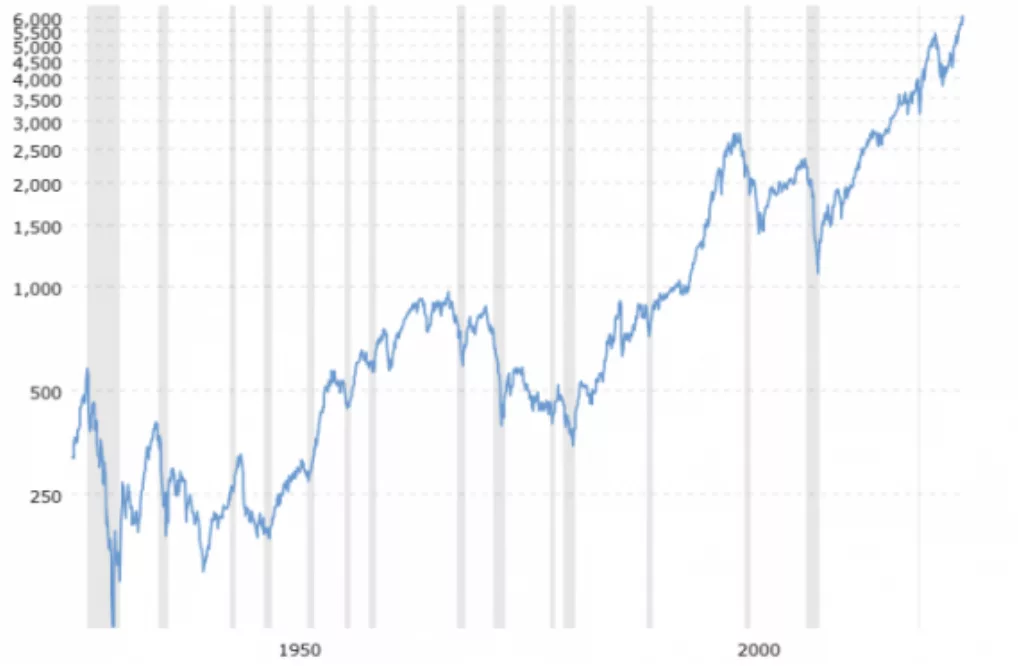
By Patricia Chadwick
The stock market is one, among a number, of leading indicators of the U.S. economy. Other such indicators include: new orders for both nondefense capital goods and also for consumer goods; consumer confidence; building permits for new homes; retail sales; and initial claims for unemployment insurance. The strength or weakness of those pillars of the economy are harbingers of future growth or decline in the GDP. Other measures—for example, employment, production and sales—are identified as co-incident indicators of economic activity because they simply explain what is currently happening within the economy. And then there are lagging indicators. Most notable among them are the unemployment rate and corporate profits—both of them are evidence that the economy has already slowed down or gone into recession. So, you might ask, how is the stock market an indicator of the future direction of the economy? The answer is, very simply: stock prices reflect the anticipated future earnings of publicly held corporations. If the outlook for the economy is looking bright, so too will the prospects for corporate earnings, and as a company’s earnings grow, it logically follows that the valuation of its stock will do so as well.
Twelve months ago, there were many naysayers among economists and stock market watchers. With the Fed Funds (short term interest) rate at 5.3%–a level not seen since before The Great Recession in 2008, mortgage rates were sitting close to 9%, a 24-year high. People with long-held, low-rate mortgages were reluctant to sell their homes and take on new, more expensive financing, which put a serious damper on the housing industry. As a leading indicator of economic growth, the sluggish housing starts data caused many to fear an impending recession. However, there was offsetting good news—the high Federal Funds rate had the intended impact of reducing inflation. From its high in 2022, inflation had its most precipitous decline in half a century—a trend that continued to make progress through the end of 2024. Employment was the shining star of the economic landscape last year, despite there being some pockets of the U. S. economy that faced a slowdown. Contrary to “old school” theories of economics that falling unemployment will lead to inflationary wage increases, the beneficial impact of rising labor productivity allowed workers to reap the benefits of growing real wages.
In November, the change in leadership in Washington begged the age-old question: What does history tell us about the U.S. stock market performance under Democrat administrations versus Republican administrations? Logic might assume that the during periods when the president was a Republican, the benefits of low-tax policies and incentives to invest capital might provide a record of outperformance. However, over the span of more than 65 years, there has been slight outperformance under a Democrat presidency. There is no moral to that statistic and the difference is not remarkable. Despite a tsunami of political promises made since November, including threats of tariffs of monumental proportion, the economic impact of those threats is almost guaranteed to be tempered by pragmatism. The U. S. economy, relative to its industrialized country competitors, particularly in Europe, is strong. Inflation has moderated to a level that is no longer threatening consumers’ purchasing power. Food prices remain sticky, particularly when it comes to eggs. Blame the avian flu which has now wreaked havoc with egg production for over two years and there’s little end in sight. Low inflation is good; deflation, on the other hand, is harmful—it decreases any incentive to spend, creating a “why buy today when the price might come down tomorrow?” syndrome. Productivity will continue to improve, aided and abetted by the benefits of artificial intelligence (AI). There is plenty of low hanging fruit in this new world of analytics, and it’s hard to imagine any sector of the U. S. economy that won’t find opportunities to reduce costs and enhance profitability. AI will certainly lead to economic disruptions—think what the introduction of the automobile to the mass market in the early 20th century did to the manufacture of horse drawn carriages and all the paraphernalia that were part of that mode of transportation. But automotive factory jobs far outstripped the industry that was annihilated. That is but one example among countless other industries that died at the hands of new technology. The future holds the same.
Last year at this time, I was full of optimism about the U. S. economy and the stock market. 2024 proved to be an excellent year for equity investors, with the S&P500 returning 25%. I remain optimistic that the investment environment will continue to be favorable, although it goes without saying that the trajectory for the market will include corrections and volatility. Tensions exist on many fronts, including between the U. S. and its trading partners; regarding ongoing wars; on issues of nuclear proliferation; around cybersecurity. But challenges like those have been part and parcel of the life of this country since its inception. They will continue to be so in the future.
Patricia Chadwick is a businesswoman and an author. Her second memoir, Breaking Glass, with the subtitle: Tales from the Witch of Wall Street, came out on May 14, 2024. It tells of her “growing up” and succeeding in what was then the all-male bastion called Wall Street. Her second book is a sequel to her first Memoir, Little Sister, the story of her childhood in a religious community-turned-cult. www.patriciachadwick.com



